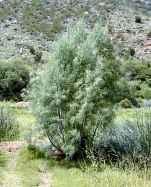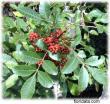Invasives Plant List in the Carlsbad Hydrologic Unit
These are just some of the invasive plants threatening our local sagebrush, riparian, and wetlands eco-systems.
giant reed (Arundo donax)* Arundo which spread during floods is clogging rivers and streams as it is a fast growing invasive. This is not a bamboo. See full color brochure on this invader. *Target of Invasive Removal Grant. |
|
 |
pampas grass (Cortaderia sp.)*, Pampas Grass increases the state's susceptibility to summer wildfires. Besides its invasive character, the stems are sharp and can cut your fingers. See full color brochure on this invader. * Target of Invasive Removal Grant |
| castor bean (Ricinus communis). Myoporum laetum, This non native is poisonous. See full color brochure on this poisonous invasive. |
|
| fountain grass (Pennisetum setaceum) This grown along rivers and in between concrete. |
|
| tree tobacco (Solanum mexicanum) or ( Nicotiana glauca Grah ) |
|
 |
salt cedar (Tamarix sp.), Salt Cedar drinks up water and prevents survival of native vegetation during dry periods. |
 |
periwinkle,Vinca major, |
 |
fennel (Foeniculum vulgare), Fennel crowds out sage scrub and grasslands habitats. |
 |
perennial pepperweed, or white top (Lepidium latifolium ), |
 |
Brazilian pepper (Schinus terebinthifolius) , |
 |
yellow starthistle, (Centaurea solstitialis), |
 |
cape ivy (Senecio mikanioides), |
 |
sea fig (Carpobrotus edulis) |
| Washingtonia fillifera and other palms | |
| eucalyptus species | |
 |
artichoke thistle (Cynara cardunculus) Artichoke Thistle makes rangeland unsuitable for grazing animals. |
Other Invader Plants:
Other invasive plants that pose are a nuisance and problematic for home gardeners. Here are just a few of of the invasive plants that have plagued homeowners and made them regret the day they planted these invaders.
See Alien Weed Invaders for a complete description of over 50 invasive plants.
For more information on invasives and invasive removal:
- Go to main Invasive for a more detailed look at the invasive problem in the Carlsbad Hydrodlogic Unit (CHU).
- See an expanded invasives plant list causing problems in the CHU.
- Print the brochures on the most problematic invasives in our watersheds.
- Read the Union-Tribune article on the Invasive Removal Project.
- Learn about the full removal and scientific scope of the Invasive Removal Grant.

